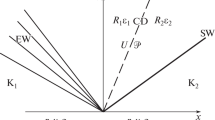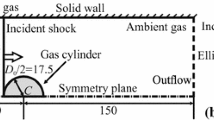Abstract
Some examples of flows with separation zones andmovable contact discontinuities obtained as a result of the numerical integration of the time-dependent equations for an ideal gas are presented. The examples concern a steady annular separation zone on the blunt nose of a body in a supersonic flow, periodic shedding of unsteady discontinuities from a cylinder in a steady uniform subsonic flow with a supercritical Mach number, and the complicated deformation of a contact (tangential) discontinuity, namely, the boundaries of a two-dimensional jet, either subsonic or supersonic, flowing into a cocurrent subsonic low-velocity flow. A multiple increase in the difference grid capacity in the numerical integration of the Euler equations indicates the absence of a noticeable scheme viscosity effect in the examples calculated. The inviscid nature of the separation flows obtained is also confirmed by their well-known counterparts constructed in the ideal incompressible fluid approximation. The time-average velocity fields of the two-dimensional jet and the intensity of its sound field are in reasonable agreement with the available data.
Similar content being viewed by others
References
A. B. Shabat, “A scheme of plane fluid flow in the presence of a bottom trench,” Zh. Prikl. Mekh. Tekhn. Fiz., No. 4, 68 (1962).
V. S. Sadovskii, “Constant vorticity region in a plane potential flow,” Uch. Zap. TsAGI, 1, No. 4, 1 (1970).
V. S. Sadovskii, “Vortex zones in a potential flow with a jump of the Bernoulli constant on its boundary,” Prikl. Mat. Mekh., 35, 771 (1971).
J. Norbury, “A family of steady vortex rings,” J. Fluid Mech., 57, 417 (1973).
L. A. Kozhuro, “A family of axisymmetric vortex flows with a Bernoulli constant discontinuity surface, ” Prikl. Mat. Mekh., 45, 88 (1981).
V. S. Sadovskii, “Plane vortex-potential inviscid flows and their application,” Tr. TsAGI, No. 2447 (1989).
R.H. Edwards, “Leading-edge separation from delta wings,” J. Aeronautical Sci., 21, 134 (1954).
C. E. Brown and W.H. Michael Jr., “Effect of leading-edge separation on the lift of a delta wing, ” J. Aeronautical Sci., 21, 690 (1954).
V. I. Kopchenov, A.N. Kraiko, and S.K. Shchipin, “Self-similar problem of separated ideal-fluid flow over an expanding plate,” Fluid Dynamics, 23, No. 5, 693 (1988).
D. E. Dyer, S. P. Fiddes, and I. H. B. Smith, “Axisymmetric vortex formation from cones at incidence — a simple inviscid model,” Aeronaut. Quart., 33, 293 (1982).
M.G. Goman and A.N. Khrabrov, “Formation of an asymmetric separated flow past slender bodies of revolution at high angles of attack,” Uch. Zap. TsAGI, 15, No. 6, 1 (1984).
A.N. Kraiko and K. S. Reent, “Inviscid nature of the asymmetry of the uniform separated flows past symmetric bodies,” Prikl. Mat. Mekh., 63, 63 (1999); see also: A.N. Kraiko (ed.), Gas Dynamics. Selected Works. Vol. 1 [in Russian], Fizmatlit, Moscow (2001), p. 246.
V. I. Kopchenov, A.N. Kraiko, and K. E. Lomkov, “Unsteady separated inviscid incompressible flow past an instantaneously accelerated flat plate of finite width,” Uch. Zap. TsAGI, 28, No. 1, 53 (1997).
A.A. Nikol’skii, “On the ’second’ form of ideal fluid flow past a body (study of separated vortex flows),” Dokl. Akad. Nauk SSSR, 116, 193 (1957).
S. M. Belotserkovskii and M. I. Nisht, Separated and Separationless Ideal Fluid Flow past Thin Wings [in Russian], Nauka, Moscow (1978).
A. N. Kraiko, D. E. Pudovikov, K. S. P’yankov and N. I. Tillyaeva, “Axisymmetric noses of a given aspect ratio, optimal or near-optimal for the wave drag,” Prikl. Mat. Mekh., 67, 795 (2003).
A.N. Kraiko and K. S. P’yankov, “Designing supercritical airfoils and nacelles in a transonic inviscid gas flow,” Zh. Vychisl. Mat. Mat. Fiz., 40, 1890 (2000); see also: A.N. Kraiko, A. B. Vatazhin, and A.N. Sekundov (eds.), Gas Dynamics. Selected Works. Vol. 2 [in Russian], Fizmatlit, Moscow (2001), p. 250.
S.K. Godunov, A.V. Zabrodin, M.Ya. Ivanov, A.N. Kraiko, and G. P. Prokopov, Numerical Solution of Multi-Dimensional Problems of Gasdynamics [in Russian], Nauka, Moscow (1976).
V. P. Kolgan, “Using the principle of minimum values of a derivative for constructing difference schemes for calculating discontinuous gasdynamic solutions,” Uch. Zap. TsAGI, 3, No. 6, 68 (1972).
A.V. Rodionov, “A monotonic second-order scheme for calculating nonequilibrium flows with discontinuity capturing,” Zh. Vychisl. Mat. Mat. Fiz., 27, 585 (1987).
A.V. Rodionov, “Increasing the approximation order of the Godunov scheme,” Zh. Vychisl. Mat. Mat. Fiz., 27, 1853 (1987).
N. I. Tillyaeva, “Generalization of the modified Godunov scheme to arbitrary irregular grids,” Uch. Zap. TsAGI, 17, No. 2, 18 (1986); see also: A.N. Kraiko, A.B. Vatazhin, and A.N. Sekundov (eds.), Gas Dynamics. Selected Works. Vol. 2 [in Russian], Fizmatlit, Moscow (2001), p. 201.
A. N. Kraiko, V. E. Makarov, and N. I. Tillyaeva, “Numerical construction of shock fronts,” Zh. Vychisl. Mat. Mat. Fiz., 20, 716 (1980); see also: A.N. Kraiko, A.B. Vatazhin, and A.N. Sekundov (eds.), Gas Dynamics. Selected Works. Vol. 2 [in Russian], Fizmatlit, Moscow (2001), p. 169.
É.G. Shifrin, “Compression shock in the transonic flow around a convex corner,” Fluid Dynamics, 9, No. 5, 712 (1974).
V. S. Boichenko and Yu.B. Lifshits, “Transonic flow around a convex corner,” Uch. Zap. TsAGI, 7, No. 2, 8 (1976).
A. I. Esin and A. I. Chernov, “On the shock in flow around a convex corner,” Prikl. Mat. Mekh., 41, 292 (1977).
A. I. Esin and A. I. Chernov, “On the local flow around a convex corner,” in: Aerodynamics. Collection of Papers. Issue 6 (9) [in Russian], Saratov Univ. Press, Saratov (1978), p. 17.
V. L. Grigorenko and A.N. Kraiko, “Internal shocks in supersonic inviscid flow past wedge-plate and conecylinder bodies,” Prikl. Mat. Mekh., 50, 91 (1986).
G. G. Chernyi, Gas Dynamics [in Russian], Nauka, Moscow (1988).
A. B. Bogod, B. S. Zamfort, M.Ya. Ivanov, and A.N. Kraiko, “Use of the time-establishment processwhen solving problems relating to the steady flow of gas around a cascade of profiles,” Fluid Dynamics, 9, No. 4, 597 (1974).
N. L. Efremov, A.N. Kraiko, and K. S. P’yankov, “Axisymmetric minimum-drag nose with given dimensions and volume,” Prikl. Mat. Mekh., 69, 723 (2005).
B. E. Edney, “Anomalous heat transfer and pressure distribution on blunt bodies at hypersonic speeds in the presence of an impinging shock,” The Aeronaut. Res. Institute of Sweden, Report 115, Stockholm (1968).
J. C. Tannenhill, T. L. Holst, and J.V. Rakich, “Numerical computation of two-dimensional viscous blunt body flows with an impinging shock,” AIAA J., 14, 204 (1976).
J. C. Tannenhill, T. L. Holst, J.V. Rakich, and J.W. Keyes, “Comparison of two-dimensional shock impingement computation with experiment,” AIAA J., 14, 539 (1976).
J. C. Tannenhill, Y. C. Vigneron, and J.V. Rakich, “Numerical solution of two-dimensional turbulent blunt body flows with an impinging shock,” AIAA J., 17, 1289 (1979).
A. N. Ganzhelo, A.N. Kraiko, K. S. P’yankov, and N. I. Tillyaeva, “Increasing the accuracy of the solution of gasdynamic problems,” in: Modern Problems of Aeromechanics [in Russian], Mashinostroenie, Moscow (1987), p. 87.
V. I. Bogdanov, A. N. Kraiko, K. S. P’yankov, and N. I. Tillyaeva, “Contouring an asymmetric nozzle with timedependent stagnation parameters of the issuing gas andminimum throat dimensions,” Aeromekh. Gas. Din., No. 3, 43 (2002).
A. N. Kraiko, K. S. Pyankov, and N. I. Tillyaeva, “Optimal nozzle design when time-changing its throat size and pressure ratio,” in: XVI Int. Symp. on Air Breathing Engines (ISABE). Cleveland, Oh, USA, 2003, ISABE-2003-1117.
M. Van Dyke, An Album of Fluid Flows, The Parabolic Press, Stanford (1982).
H.H. Korst, “A theory for base pressure in transonic and supersonic flow,” J. Appl. Mech., 23, 593 (1956).
R.K. Tagirov, “Calculation of the base pressure and the parameters of the separated flow behind a plane step in sonic and supersonic flow,” Tr. TsIAM, No. 538 (1972).
V.Ya. Neiland, V.V. Bogolepov, G.N. Dudin, and I. I. Lipatov, Asymptotic Theory of Supersonic Viscous Flows [in Russian], Fizmatlit, Moscow (2004)
L.D. Landau and E. M. Lifshitz, Fluid Mechanics, Pergamon, London (1959).
W. Blumen, “Jet flow instability of an inviscid compressible fluid,” J. Fluid Mech., 46, 737 (1971).
K. S. P’yankov, “Modeling jet noise and determining its acoustic characteristics on the basis of the time-dependent Euler equations,” in: Proceedings of the Fourth Intern. Seminar “Models and Methods of Aerodynamics”, Evpatoria, June 2004 [in Russian], Moscow (2004), p. 101.
J. E. Ffocs Williams and D. L. Hawkings, “Sound generated by turbulence and surfaces in arbitrary motion,” Phil. Trans. Royal Soc., Ser. A, 264, No. 1151, 321 (1969).
G. N. Abramovich, Applied Gas Dynamics. Part 1 [in Russian], Nauka, Moscow (1991).
M. J. Lighthill, “On sound generated aerodynamically. Part I. General theory,” Proc. Royal Soc., Ser. A, 211, No. 1107, 564 (1952).
M. J. Lighthill, “On sound generated aerodynamically. Part II. Turbulence as a source of sound, ” Proc. Royal Soc., Ser. A, 222, No. 1148, 1 (1954).
Additional information
__________
Translated from Izvestiya Rossiiskoi Academii Nauk, Mekhanika Zhidkosti i Gaza, No. 5, 2006, pp. 41–54.
Original Russian Text Copyright © 2006 by Kraiko and P’yankov.
Rights and permissions
About this article
Cite this article
Kraiko, A.N., P’yankov, K.S. Ideal gas flows with separation zones and time-dependent contact discontinuities of complicated shape. Fluid Dyn 41, 708–724 (2006). https://doi.org/10.1007/s10697-006-0090-3
Received:
Issue Date:
DOI: https://doi.org/10.1007/s10697-006-0090-3




